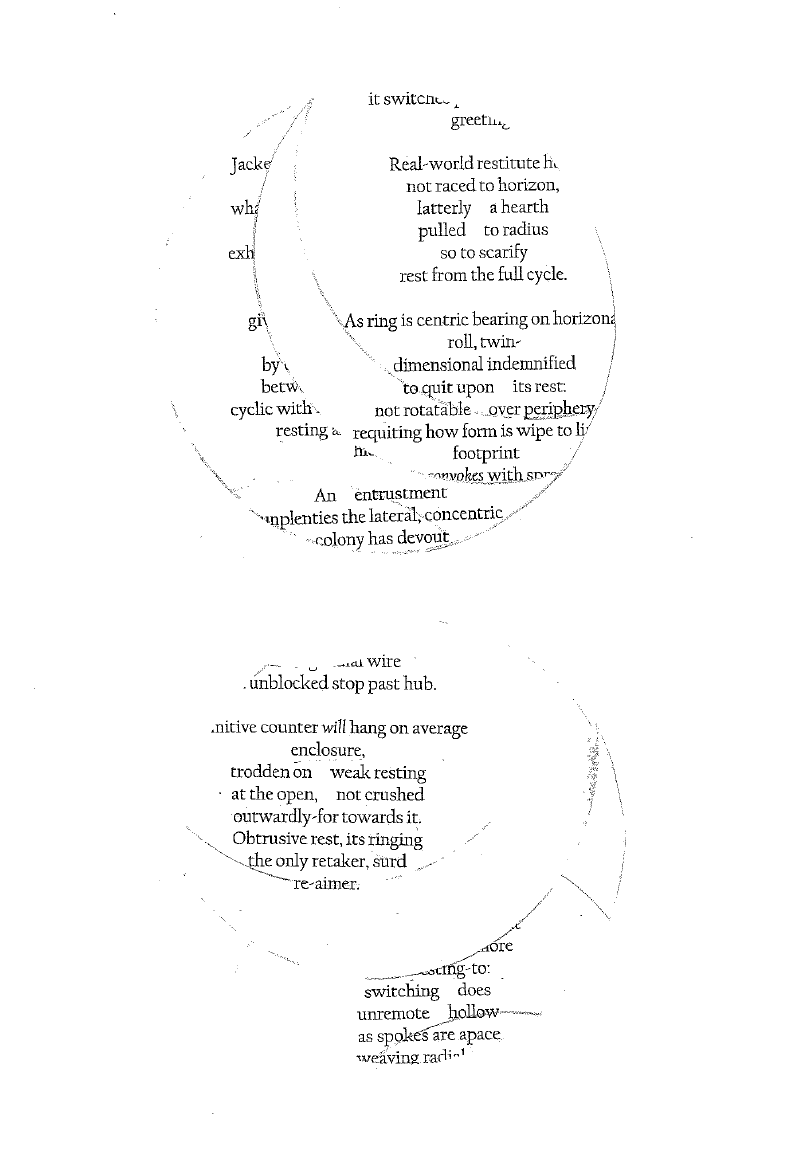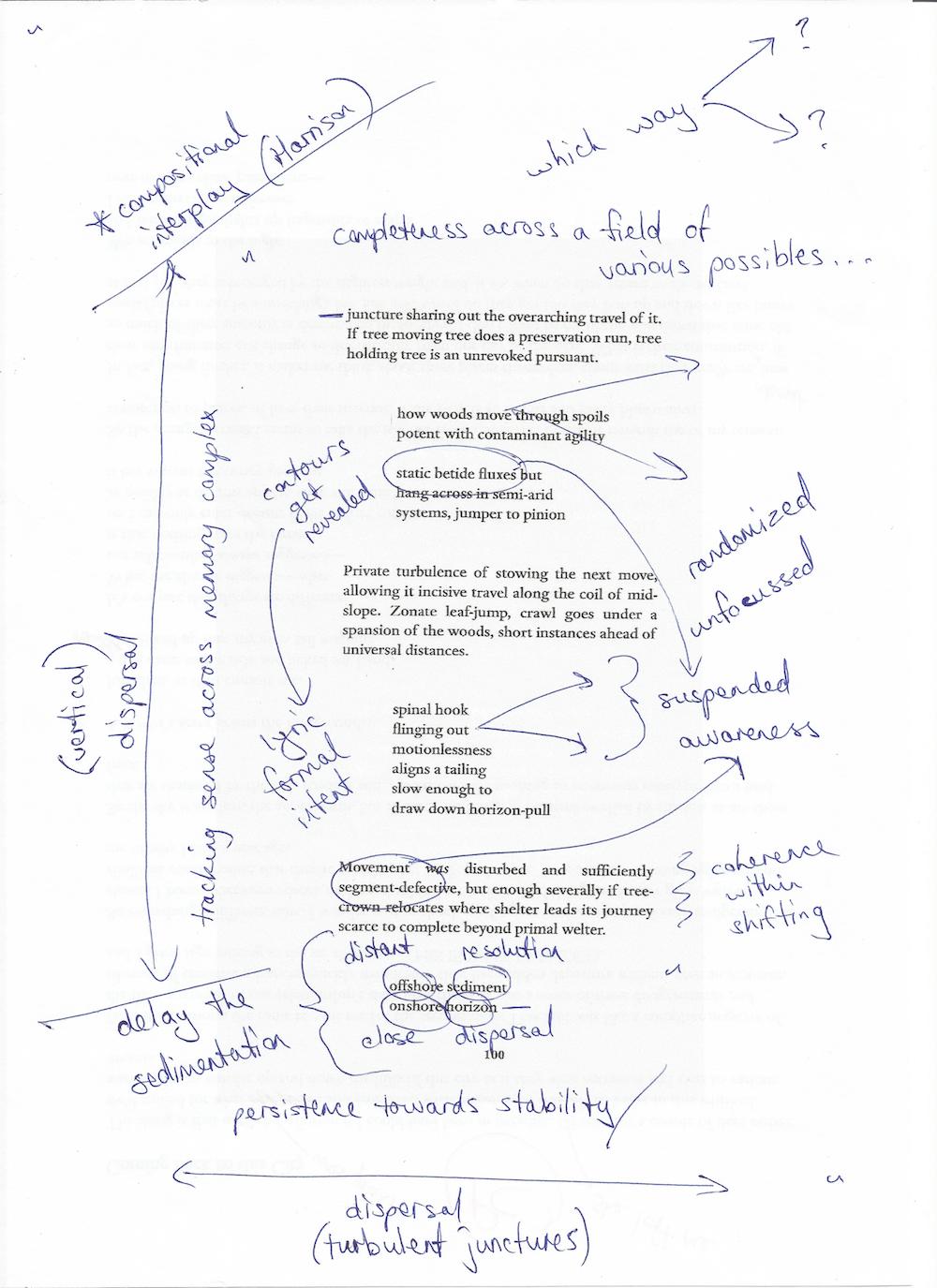Stephen Collis
Notes on Rings Resting the Circuit
1. I think I got my copy of Peter Larkin’s Rings Resting the Circuit directly from Nate Dorward of The Gig, who knows how long ago. I was traveling, somewhere in eastern Canada or the US, before circling back home to the west coast. Larkin’s work has remained for me a limit—but an open limit (c.f. Larkin’s epigraph from Gustave Roud, une limite, mais une limite toujours ouverte)—and thus an invitation—to which I return again and again.
2. Robert Duncan: “We begin to see that the intention of the boundless is manifest in the agony and restoration of pages or boundaries or walls.” Every boundary spawns its beyondery, which we at once fear and draw towards—the mobile horizon that moves with us capturing new bounds and throwing out new beyonds. Larkin: “a frontier which lies and rests and summons.” That the “surface…which surrounds is always less than the reach of what is surrounded.” So in our conceptual circling we inscribe beyonderies outside our circumferencing that summon us outside the still point upon which our compass turns. Again and again, lighting out as we spiral round.
3. John Clare: “I had imagined that the worlds end was at the edge of the orison & that a days journey was able to find it so I went on with my heart full of hopes pleasures & discoverys expecting when I got to the brink of the world that I could look down like looking into a large pit & see into its secrets the same as I believed I could see heaven by looking into water.”
4. The underlying literary pattern of the spiral, seemingly ubiquitous though at often subsurface levels, links to our tendency to think in terms of organics again and again—“everything is medial,” Emerson writes in “Circles,” and “The natural world may be conceived of as a system of concentric circles.” Tree ring. Pond surface. The long life of literary repetition is a circling on and out and through sound and reference. Larkin again: “innate forms of self-organization,” rings “rest” by being spun on an axis; “its circuiting not as closure but as bidding.” We rotate towards our next encircling, arcing out and in again.
5. “A common earth sits in on the micro-enringings which knit it.” These micro-enringings are mostly made of and by beings beating their bounds. Territories made by the circuit of trails, transhumance and transbiosis—paths which overlap, enring, cross-orbit, and thus knit together a picture of shared terrain—a “common earth” revealed in worn paths across open terrain.
6. That which forms rings on this earth because of its orbital eye neck and ambulatory body needs a surface to provide a surround. That which forms such rings is multiple, a singular plural being, a common circuitry, coming around again and again in repeated and overlapping acts of horizoning.
7. The horizon—that circle we make by both moving and being at rest. Our horizon wobbles as we move about our days as inconsistent axes. If we could track this with time-lapse photography, from overhead, our life would be a series of repeated and mostly overlapping circuits—with the occasional asteroidal long arc reaching out and spiralling back into the usual circuit’s surround.
8. The axis upon which the horizon turns is peculiar to the position of the percipient—but—I’m again drawn to the social massing of micro-enringings. What of the multitude of makers of horizons commoning inside these overlapping rings together? The commons, a kind of enclosure against enclosure by being a “weak resting,” broken and re-set via repetition, is the near but not perfect overlapping of a multitude of circlings that are mutually self-sustaining. The commons needs the beyondery at its limit, where enclosure’s only open to more (a pure lack of limit).
9. Larkin: “I remain fascinated with how the figure of the ring is fully closed on its horizontal axis but blankly open on the vertical.” In Rings Resting the Circuit, we look at the sides of multiple circles on horizontal planes—each circuit spun one on top of the other on the same central axis centering lines. Thus the poetry “rests” while turning. But—I found the beyondery of the blankly open vertical too inviting. Centering new circuits on the axis of the word “ring,” wherever it recurred, I made new circles from the vertical, looking down on (or up through) Larkin’s plane of layered horizons. My rings cut verticals across Larkin’s horizontals. If the author is bound to a particular horizon once a work is in print, the reader, a bird high above the enclosed page, can follow new circuits on thermals above the page.
10. In Larkin’s essay “Wordsworth’s First of Homes,” the romantic poet’s desire for the protection of the “bounds of the vale” of Grasmere leave “numerous gaps ... within the circled sphere itself” (38). One of these “gaps” is again that of the vertical axis above the horizonal vale where the birds in Home at Grasmere are (in Larkin’s terms) “marginal dwellers at the bounds ... partial presences” for which “the vale is a circular passage rather than a securable enclosure” (39). In Rings Resting I cannot help but sense that Larkin has taken on the poetics of Wordsworth’s birds—has invited a reading strategy that spirals up and out of containment, following the concentric rings that scale up and out from each instant of the circular indexically marked on the poet’s page.
11. Wordsworth, Home at Grasmere:
I cannot take possession of the sky,
Mount with a thoughtless impulse and wheel there
One of a mighty multitude, whose way
And motion is a harmony and dance
Magnificent. Behold them, how they shape
Orb after orb their course still round and round
Above the area of the Lake, their own
Adopted region, girding it about
In wanton repetition, yet therewith
With that large circle evermore renewed:
Hundreds of curves and circlets high and low,
Backwards and forwards, progress intricate,
As if one spirit was in all and swayed
Their indefatigable flight. (288-301)
12. Circles are at once marks of our finitude and lines drawn out into seemingly infinite beyonds. The stone circle where we sit on surface to gaze at the orbits of comets. We pronounce no navigational systems beyond our ability to find ourselves within horizon, and the arcs we might imagine swinging out into beyondery, moving horizon with us—under stars and birds similarly circling larger circuits than our horizoned surfaces.
13. In Larkin the elements forming ringing spiral out beyond boundary or overlap, repeat, and cancel each other again and again, with each marking of the circular—enringing, spinner, spokes, radial, hub, ringing, horizon, axially, ring, crater, hoop, spindle, round, axle, hoopstream, axis, concentric, radius, cycle, centric, horizonal—it cannot stop yet stops on the axis of each line holding pattern permanently impermanent.
14. With each writing of the poem we project at once a new state of rest upon a page and at once a printed boundary poetry reaches beyond into possible sequence or continuity.


